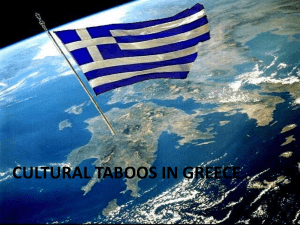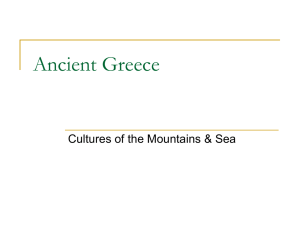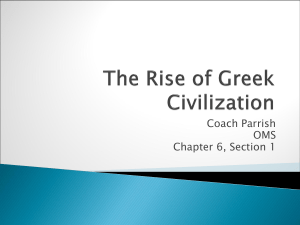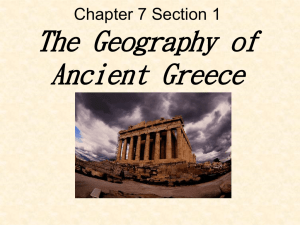Ancient Greece Geo
advertisement
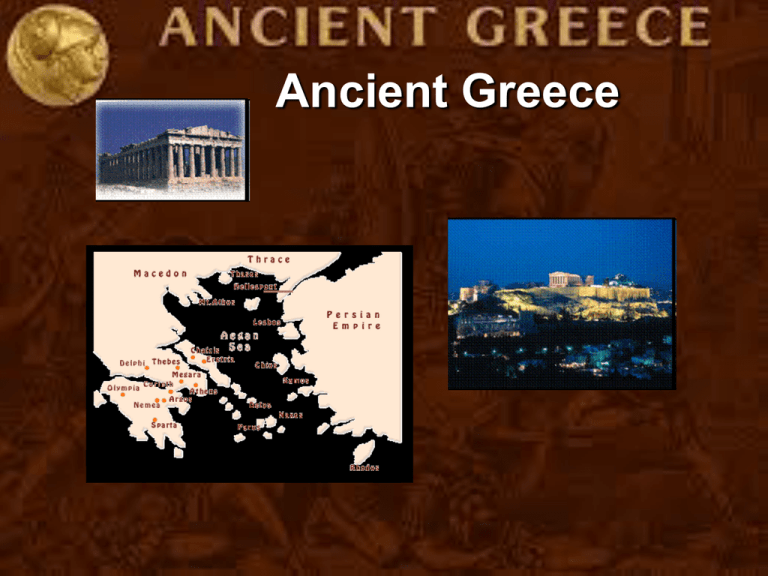
Ancient Greece • Greece, a country in southeastern Europe whose peninsula extends from the Balkans into the Mediterranean Sea, is mountainous, with many gulfs and bays. • Forests fill some areas of Greece. • Much of Greece is stony and suitable only for pasturage, but other areas are suitable for growing wheat, barley , citrus, dates , and olives. 3 Major Periods of Ancient Greece Civilizations 1. Early Civilizations: Minoans (Crete) and Mycenae (mi se ne) 2. Classical Greece (flourishing of arts, literature, philosophy; domination by Sparta and Athens) 3. Hellenistic Age: Macedonia Empire and Alexander the Great It is convenient to divide ancient Greece into 3 geographical regions (plus islands and colonies): • 1) Northern Greece, (2) Central Greece and (3) The Peloponnese I. Northern Greece • Northern Greece consists of Epirus and Thessaly, separated by the Pindus mountain range. • The chief town in Epirus is Dodona where the Greeks thought Zeus provided oracles. I. Northern Greece • Thessaly is the largest plains area in Greece. • It is almost surrounded by mountains. • On the north, the Cambunian range has as its highest mountain the home of the gods, Mt. Olympus, and nearby, Mt Ossa. • Between these two mountains is a valley called the Vale of Tempe through which runs the Peneius River. II. Central Greece • Central Greece has more mountains than northern Greece. • It contains the countries of Aetolia (famed for the Calydonian boar hunt), Locris (divided into 2 sections by Doris and Phocis), Acarnania (west of Aetolia, bordered by the Achelous River, and north of the gulf of Calydon), Doris, Phocis, Boeotia, Attica, and Megaris. II. Central Greece • Boeotia and Attica are separated by Mt. Cithaeron • In northeast Attica is Mt. Pentelicus home of the famous marble. South of Pentelicus is the Hymettus mountain range, which is famous for its honey. Attica had a poor soil, but a long coastline favoring trade. • Megaris lies in the Isthmus of Corinth, which separates central Greece from the Peloponnese. II. Central Greece • The Megarans raised sheep and made woolen products and pottery. III. Peloponnesus • South of the Isthmus of Corinth is the Peloponnese (21,549 sq. km), whose central region is Arcadia, which is a plateau over mountain ranges. III. Peloponnesus • On the northern slope is Achaea, with Elis and Corinth on either side. • On the east of the Peloponnese is the mountainous Argolis area. • Laconia was the country in the basin of the Eurotas River, which ran between the Taygetus and Parnon mountain regions. Messenia lies to the west of Mt. Taygetus, the highest point in the Peloponnese. What are the characteristics of Ancient Greece’s geography? Geographic Features 1.Sea: heavy influence on physical environment of Greece (Aegean Sea, Ionian Sea) 2.Mountains (with narrow valleys): cover more than ¾ of Greece’s surface area and islands: more than 2000 islands (Crete being the largest) 3.No major rivers on Greek mainland but fertile soil 4.Climate: winter= mild climate; summer= hot climate with rainfall from October to March = long growing season Resources and Crops RESOURCES • grain • fine cheese made of goat’s milk • timber • wild game • wool of sheep = cloth MOST IMPORTANT CROPS • olives = oil • grapes = wine • grain • clay = pottery Effects of Geography • Seafaring tradition: reliance on navy and fleets for power and protection • Sea provided link to trade and cultural exchange with Mediterranean communities • Isolationism: protection but lack of effective communication • Greece was organized into polis (independent city states) separated by seas and rugged mountains • Emergence of dominant city states (Athens, Sparta)


